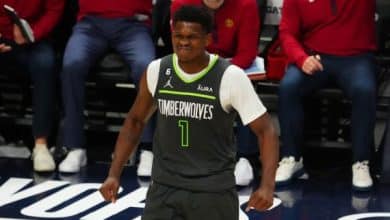
“They are big and they use their size. They block a lot (with screens in the racket on penetrations). They open up the field for each other with sometimes some pretty crazy screens.”
Jaren Jackson Jr. and the Grizzlies once again noted the inner power of the Wolves, ultra dominant on the rebound and overall in the paint in Memphis, behind Rudy Gobert (16 points, 20 rebounds and 6 blocks), Karl-Anthony Towns (24 points, 7 rebounds and 5 assists) or Naz Reid (10 points and 9 rebounds).
The Karl-Anthony Towns – Rudy Gobert duo works
Best record in the NBA at the moment (17 wins – 4 losses) and best defense in the league (106.2 points conceded over 100 possessions), the Wolves have had the best start to a campaign in their entire history. And they owe it in particular to a great Rudy Gobert, back to his best level defensively.
While he had experienced a complicated first season with the Wolves, the Frenchman put the Minneapolis public in his pocket, the fans did not hesitate to give him a standing ovation during his exits at the end of the match.
But perhaps the most interesting thing is that his duo with Karl-Anthony Towns works, both in attack and defense! Last season, the two men were only able to play 27 games together, and 529 minutes in total. But the tandem seemed to step on each other's toes, with a very average “Net Rating” (difference between points scored and conceded, over 100 possessions, with both players on the field) of +0.6. We also remember that Anthony Edwards did not hesitate to complain about the lack of space he had with the “Twin Towers” on the field, no longer really daring to attack the circle as there seemed to be so many people in it. the opposing racket.
Total change of face this season, with a duo Rudy Gobert – Karl-Anthony Towns which displays a superb “Net Rating” of +13.7 in 21 matches, and 453 minutes shared! Same thing for the Gobert/Towns/Edwards trio, at +8.1 this season while it only posted +2.3 last season.
Less used on the pick-and-roll, but more on the “seals”
It is especially the offensive efficiency of the Gobert – Towns tandem (118.8, the best for a Wolves duo having been used more than 10 minutes per game this season) which is interesting, especially when we compare it to that of last year. passed (106.2). So what happened in Minnesota? With 13.5 points per game at 61.8% success, Rudy Gobert has not yet become an offensive weapon of mass destruction, and his numbers on this side of the field are even worse than during his last seasons at Utah.
Even if we note that over the last 10 matches, Rudy Gobert is averaging 16.1 points at 72.4% success!
The alley-oops offered by Karl-Anthony Towns have something to do with it, but the Frenchman is less served on the pick-and-roll than during his years in Salt Lake City. This is because to “reward” Rudy Gobert, as Chris Finch says, the Wolves seem to prefer another path. The native of Saint-Quentin does not have very sure hands in attack, the ball escaping him too often to the liking of average creators/passers like Donovan Mitchell, or even Anthony Edwards, who hesitate to serve him directly.
Even in 2018/19, when he averaged 15.9 points at 66.9% success, Rudy Gobert set a lot of screens (13.7 points generated per match on his screens) for ultimately quite few points scored on the pick-and- roll (4.5). That year, the Frenchman was (by far) the player who set the most screens in the NBA, and he was the 6th pivot in the number of points scored after the pick-and-roll. But if we look at the points/screens ratio, he was… 38th, just ahead of Ante Zizic and Bismack Biyombo.
At the Wolves, we of course use the pick-and-roll with Rudy Gobert, whose cuts towards the circle attract assists and help to destabilize the defenses, but to serve the pivot, we use something else. Because if he is still in 6th place among players whose screens produce the most points (11.3), he fell to 19th place in terms of points scored on pick-and-roll (2.9). Because the most effective weapon of the tricolor pivot in attack seems to be the “seal”, or this way of trapping the defender under the basket.
Useful anchors for teammates and offensive rebounding
When Jaren Jackson Jr. talks about screens “pretty crazy”he thus evokes these “anchors”, with Rudy Gobert who blocked him several times to allow Karl-Anthony Towns to more easily attack the circle.
It's borderline legal, but as long as the referees don't blow the whistle, there's no point in doing without it.
More and more often, as soon as he obtains a favorable duel after “switches”, Rudy Gobert will therefore “anchor himself” in the racket, which allows him to help create access to the circle in the event of penetration of a teammate, while being a target for the pass, from Karl-Anthony Towns in particular.
He can also do it on counter-attacks, when he has his defender at his back.
Rudy Gobert obviously didn't wait until this season to use the “seals” but the particularly interesting point is that the Wolves use them on purpose, especially from the side.
For Chris Finch and the Wolves, it's a smart and effective way to use the Frenchman's physical impact, to reward him for his defensive activity while involving him on the other side of the field outside of the pick-and-place. roll, where it is more expected and less effective. Especially since his “anchors” also serve his teammates, and allow him to be present on the offensive rebound, where he has had his best campaign (4.0 shots) since his arrival in the NBA.
| Rudy Gobert | Percentage | Rebounds | |||||||||||||
|---|---|---|---|---|---|---|---|---|---|---|---|---|---|---|---|
| Season | Team | MJ | Min | Shots | 3pts | L.F. | Off | Def | Early | Pd | Party | Int | Bp | Ct | Pts |
| 2013-14 | UTH | 45 | 10 | 48.6 | 0.0 | 49.2 | 1.1 | 2.3 | 3.4 | 0.2 | 1.3 | 0.2 | 0.7 | 0.9 | 2.3 |
| 2014-15 | UTH | 82 | 26 | 60.4 | 0.0 | 62.3 | 3.2 | 6.2 | 9.5 | 1.3 | 2.1 | 0.8 | 1.4 | 2.3 | 8.4 |
| 2015-16 | UTH | 61 | 32 | 55.9 | 0.0 | 56.9 | 3.4 | 7.5 | 11.0 | 1.5 | 2.7 | 0.7 | 1.9 | 2.2 | 9.1 |
| 2016-17 | UTH | 81 | 34 | 66.1 | 0.0 | 65.3 | 3.9 | 8.9 | 12.8 | 1.2 | 3.0 | 0.6 | 1.8 | 2.6 | 14.0 |
| 2017-18 | UTH | 56 | 32 | 62.2 | 0.0 | 68.2 | 3.0 | 7.8 | 10.7 | 1.4 | 2.7 | 0.8 | 1.9 | 2.3 | 13.5 |
| 2018-19 | UTH | 81 | 32 | 66.9 | 0.0 | 63.6 | 3.8 | 9.0 | 12.9 | 2.0 | 2.9 | 0.8 | 1.6 | 2.3 | 15.9 |
| 2019-20 | UTH | 68 | 34 | 69.3 | 0.0 | 63.0 | 3.4 | 10.1 | 13.5 | 1.5 | 3.2 | 0.8 | 1.9 | 2.0 | 15.1 |
| 2020-21 | UTH | 71 | 31 | 67.5 | 0.0 | 62.3 | 3.4 | 10.1 | 13.5 | 1.3 | 2.3 | 0.6 | 1.7 | 2.7 | 14.3 |
| 2021-22 | UTH | 66 | 32 | 71.3 | 0.0 | 69.0 | 3.7 | 11.0 | 14.7 | 1.1 | 2.7 | 0.7 | 1.8 | 2.1 | 15.6 |
| 2022-23 | MIN | 70 | 31 | 65.9 | 0.0 | 64.4 | 3.3 | 8.3 | 11.6 | 1.2 | 3.0 | 0.8 | 1.7 | 1.4 | 13.4 |
| 2023-24 | MIN | 21 | 33 | 61.8 | 0.0 | 63.6 | 4.0 | 8.5 | 12.4 | 1.1 | 2.9 | 0.6 | 1.6 | 2.5 | 13.5 |
| Total | 702 | 30 | 65.3 | 0.0 | 63.9 | 3.3 | 8.3 | 11.7 | 1.3 | 2.6 | 0.7 | 1.7 | 2.1 | 12.6 | |
How to read the stats? MJ = matches played; Min = Minutes; Shots = Successful shots / Attempted shots; 3pts = 3-points / 3-points attempted; LF = free throws made / free throws attempted; Off = offensive rebound; Def=defensive rebound; Tot = Total rebounds; Pd = assists; Fte: Personal fouls; Int = Intercepts; Bp = Lost balls; Ct: Against; Pts = Points.












